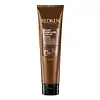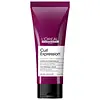What's inside
What's inside
 Key Ingredients
Key Ingredients

 Benefits
Benefits

 Concerns
Concerns

 Ingredients Side-by-side
Ingredients Side-by-side

Water
Skin ConditioningCetearyl Alcohol
EmollientBehentrimonium Chloride
PreservativeCetyl Esters
EmollientAmodimethicone
Parfum
MaskingSodium Benzoate
MaskingIsopropyl Alcohol
SolventCitric Acid
BufferingPlukenetia Volubilis Seed Oil
EmollientEthylhexyl Methoxycinnamate
UV AbsorberCetrimonium Chloride
AntimicrobialBenzyl Alcohol
PerfumingCoumarin
PerfumingLinalool
PerfumingBenzyl Benzoate
AntimicrobialAloe Barbadensis Leaf Juice Powder
Skin ConditioningHexyl Cinnamal
PerfumingLimonene
PerfumingCitronellol
PerfumingAmyl Cinnamal
PerfumingGeraniol
PerfumingCitral
PerfumingCereus Grandiflorus Flower Extract
Skin ConditioningAlpha-Isomethyl Ionone
PerfumingGlucose
HumectantLactic Acid
BufferingPotassium Sorbate
PreservativeTocopherol
AntioxidantWater, Cetearyl Alcohol, Behentrimonium Chloride, Cetyl Esters, Amodimethicone, Parfum, Sodium Benzoate, Isopropyl Alcohol, Citric Acid, Plukenetia Volubilis Seed Oil, Ethylhexyl Methoxycinnamate, Cetrimonium Chloride, Benzyl Alcohol, Coumarin, Linalool, Benzyl Benzoate, Aloe Barbadensis Leaf Juice Powder, Hexyl Cinnamal, Limonene, Citronellol, Amyl Cinnamal, Geraniol, Citral, Cereus Grandiflorus Flower Extract, Alpha-Isomethyl Ionone, Glucose, Lactic Acid, Potassium Sorbate, Tocopherol
Water
Skin ConditioningAminopropyl Triethoxysilane
C13-16 Isoparaffin
SolventLactic Acid
BufferingGlycerin
HumectantCetearyl Alcohol
EmollientIsopropyl Myristate
EmollientPolyquaternium-37
Amodimethicone
Polyquaternium-6
Propylene Glycol Dicaprylate/Dicaprate
EmollientDimethicone
EmollientHydroxypropyl Guar
Emulsion StabilisingPhenoxyethanol
PreservativeTrideceth-5
EmulsifyingSteareth-20
CleansingVp/Va Copolymer
PPG-1 Trideceth-6
Skin ConditioningTrideceth-10
CleansingSorbitan Oleate
EmulsifyingChlorhexidine Digluconate
AntimicrobialAcetic Acid
BufferingHydroxyethyl Urea
HumectantLimonene
PerfumingBenzyl Salicylate
PerfumingBenzyl Alcohol
PerfumingTetrasodium EDTA
Hibiscus Esculentus Seed Extract
Skin ConditioningParfum
MaskingWater, Aminopropyl Triethoxysilane, C13-16 Isoparaffin, Lactic Acid, Glycerin, Cetearyl Alcohol, Isopropyl Myristate, Polyquaternium-37, Amodimethicone, Polyquaternium-6, Propylene Glycol Dicaprylate/Dicaprate, Dimethicone, Hydroxypropyl Guar, Phenoxyethanol, Trideceth-5, Steareth-20, Vp/Va Copolymer, PPG-1 Trideceth-6, Trideceth-10, Sorbitan Oleate, Chlorhexidine Digluconate, Acetic Acid, Hydroxyethyl Urea, Limonene, Benzyl Salicylate, Benzyl Alcohol, Tetrasodium EDTA, Hibiscus Esculentus Seed Extract, Parfum
 Reviews
Reviews

Ingredients Explained
These ingredients are found in both products.
Ingredients higher up in an ingredient list are typically present in a larger amount.
This water-soluble silicone is used for its hydrating and softening properties. It is used to add a silky feel to skincare products and has great benefits for haircare.
In haircare, this ingredient:
- Adds shine
- Protects color
- Offers thermal protection
- Boosts hair strength
- Does not build up as easily
Benzyl Alcohol is most commonly used as a preservative. It also has a subtle, sweet smell. Small amounts of Benzyl Alcohol is not irritating and safe to use in skincare products. Most Benzyl Alcohol is derived from fruits such as apricots.
Benzyl Alcohol has both antibacterial and antioxidant properties. These properties help lengthen the shelf life of products. Benzyl Alcohol is a solvent and helps dissolve other ingredients. It can also improve the texture and spreadability.
Alcohol comes in many different forms. Different types of alcohol will have different effects on skin. This ingredient is an astringent alcohol.
Using high concentrations of these alcohols are drying on the skin. They may strip away your skin's natural oils and even damage your skin barrier. Astringent alcohols may also irritate skin.
Other types of astringent alcohols include:
According to the National Rosacea Society based in the US, you should be mindful of products with these alcohols in the top half of ingredients.
Any type of sanitizing product will have high amounts of alcohol to help kill bacteria and viruses.
Learn more about Benzyl AlcoholCetearyl alcohol is a mixture of two fatty alcohols: cetyl alcohol and stearyl alcohol. It is mainly used as an emulsifier. Emulsifiers help prevent the separation of oils and products. Due to its composition, it can also be used to thicken a product or help create foam.
Cetearyl alcohol is an emollient. Emollients help soothe and hydrate the skin by trapping moisture.
Studies show Cetearyl alcohol is non-toxic and non-irritating. The FDA allows products labeled "alcohol-free" to have fatty alcohols.
This ingredient is usually derived from plant oils such as palm, vegetable, or coconut oils. There is debate on whether this ingredient will cause acne.
Due to the fatty acid base, this ingredient may not be Malassezia folliculitis safe.
Learn more about Cetearyl AlcoholLactic Acid is another well-loved alpha hydroxy acid (AHA). It is gentler than glycolic acid but still highly effective.
Its main role is to exfoliate the surface of the skin by loosening the “glue” that holds dead skin cells together. Shedding those old cells leads to smoother, softer, and more even-toned skin.
Because lactic acid molecules are larger than glycolic acid, they don’t penetrate as deeply. This means they’re less likely to sting or irritate, making it a great choice for beginners or those with sensitive skin.
Like glycolic acid, it can:
Lactic acid also acts as a humectant (like hyaluronic acid). It can draw water into the skin to improve hydration and also plays a role in the skin's natural moisturizing factor (NMF) in the form of sodium lactate.
Studies show it can boost ceramide production to strengthen the skin barrier and even help balance the skin’s microbiome.
To get results, choose products with a pH between 3-4.
Lower strengths (5-12%) focus on surface exfoliation; higher strengths (12% and up) can reach deeper in the dermis (deeper, supportive layer) to improve skin texture and firmness over time.
Though it was originally derived from milk, most modern lactic acid used in skincare is vegan. It is made through non-dairy fermentation to create a bio-identical and stable form suitable for all formulations.
When lactic acid shows up near the end of an ingredient list, it usually means the brand added just a tiny amount to adjust the product’s pH.
Legend has it that Cleopatra used to bathe in sour milk to help reduce wrinkles.
Lactic acid is truly a gentle multitasker: it exfoliates, hydrates, strengthens, and brightens. It's a great ingredient for giving your skin a smooth, glowing, and healthy look without the harshness of stronger acids.
Read more about some other popular AHA's here:
Learn more about Lactic AcidLimonene is a fragrance that adds scent and taste to a formulation.
It's found in the peel oil of citrus fruits and other plants such as lavender and eucalyptus. The scent of limonene is generally described as "sweet citrus".
Limonene acts as an antioxidant, meaning it helps neutralize free radicals.
When exposed to air, oxidized limonene may sensitize the skin. Because of this, limonene is often avoided by people with sensitive skin.
The term 'fragrance' is not regulated in many countries. In many cases, it is up to the brand to define this term. For instance, many brands choose to label themselves as "fragrance-free" because they are not using synthetic fragrances. However, their products may still contain ingredients such as essential oils that are considered a fragrance.
Learn more about LimoneneParfum is a catch-all term for an ingredient or more that is used to give a scent to products.
Also called "fragrance", this ingredient can be a blend of hundreds of chemicals or plant oils. This means every product with "fragrance" or "parfum" in the ingredients list is a different mixture.
For instance, Habanolide is a proprietary trade name for a specific aroma chemical. When used as a fragrance ingredient in cosmetics, most aroma chemicals fall under the broad labeling category of “FRAGRANCE” or “PARFUM” according to EU and US regulations.
The term 'parfum' or 'fragrance' is not regulated in many countries. In many cases, it is up to the brand to define this term.
For instance, many brands choose to label themselves as "fragrance-free" because they are not using synthetic fragrances. However, their products may still contain ingredients such as essential oils that are considered a fragrance by INCI standards.
One example is Calendula flower extract. Calendula is an essential oil that still imparts a scent or 'fragrance'.
Depending on the blend, the ingredients in the mixture can cause allergies and sensitivities on the skin. Some ingredients that are known EU allergens include linalool and citronellol.
Parfum can also be used to mask or cover an unpleasant scent.
The bottom line is: not all fragrances/parfum/ingredients are created equally. If you are worried about fragrances, we recommend taking a closer look at an ingredient. And of course, we always recommend speaking with a professional.
Learn more about ParfumWater. It's the most common cosmetic ingredient of all. You'll usually see it at the top of ingredient lists, meaning that it makes up the largest part of the product.
So why is it so popular? Water most often acts as a solvent - this means that it helps dissolve other ingredients into the formulation.
You'll also recognize water as that liquid we all need to stay alive. If you see this, drink a glass of water. Stay hydrated!
Learn more about Water